Chromatography Fundamentals, Part X: Light Scattering Detection Systems for Size-Exclusion Chromatography
This contribution is a continuation of Part IX of this series. In that article, the fundamentals of light scattering as applied to SEC was introduced, including the origin and significance of pertinent equations related to the light scattering of macromolecules. In the present contribution, a summary of commercially available light scattering instrumentation is given, with emphasis on new detector technology. Owing to the complexity of data analysis and the many equations involved with light scattering measurements, a glossary of principal symbols and a table of relevant relationships are presented.
This review is a continuation of Part IX (1), in which the theory of light scattering is given, including pertinent equations and data analysis. The following contribution is a summary of commercially available light scattering (LS) detection systems for size-exclusion chromatography (SEC). Information was obtained, for the most part, from current web sites and discussions with manufacturers as of May 2020. Please note that the author does not endorse any specific instrument.
In addition to detector sensitivity and noise specifications, selecting a light scattering instrument depends on many other factors, including software features and technical support. Furthermore, certain instruments now include dynamic light scattering capability for characterizing aggregates and particulates, which will be the subject of Part XI of this series.
Light scattering detectors for SEC are currently available from Agilent Technologies, Brookhaven Instruments, Malvern Panalytical, Postnova Analytics, Tosoh Bioscience, and Wyatt Technology Corporation. The low-angle capabilities of Malvern’s low angle light scattering/right angle light scattering (LALS/RALS) (7°/90°) and Agilent’s dual-angle detector (15°/90°) use collimated annulus optics for low-angle measurements and photodiodes for right-angle detection. Moreover, Agilent’s instrument utilizes fiber optics to transmit scattering signals to the sensor. Other multiangle instruments employ an array of photodiodes that surround the flow cell, placed at specified angles for detecting scattered light, with the exception of Brookhaven Instruments that employs a charge-coupled device (CCD) for detection.
The apparent trend among some companies is to maximize the number detection angles for improved accuracy and precision. For example, Wyatt Technology, Malvern Panalytical, and Postnova Analytics sell instruments that have 18, 20, and 21 angles of measurement, respectively.
For most instruments, the low-molecular-weight limit ranges from about 200 to 103 g/mol. By reason of equation 7c from Part IX, the lower limit can be adjusted by increasing injection concentration. It is important to note, that when measuring the low-molecular tail of a polydisperse sample, realistic molecular-weight detection limits greatly exceed the above range. The lower radius-of-gyration limit appears to be about 10 nm, except, for example, Tosoh Bioscience LenS3 (see following section) and Postnova multiple angle light scattering (MALS) detectors, whose lower limits are approximately 5 and 8 nm, respectively, using typical injection concentrations. Here the lower limit of angular dissymmetry depends primarily on the sensitivity and signal/noise of the instrument.
It should be stressed that lower molecular-weight and radius-of-gyration limits depend, among other attributes, on instrument design, intensity and wavelength of the incident beam, scattering volume, and photocell sensitivity. Specifications are also based on such factors as the specific refractive index of the sample, injection amount, signal-to-noise ratio of the light scattering and concentration detectors, baseline drift, peak broadening from columns and detector cell volume, and other chromatographic conditions.
It is of interest to note that a radius-of-gyration limit of 10 nm corresponds to 105 g/mol for linear, random-chain polymers. For polymers that are smaller than 10 nm, viscometric detectors can be used, provided that universal calibration is valid, a topic that will be covered in Part XII of this series.
New MALS Detector Technology
Tosoh Bioscience has recently introduced a multiangle instrument (LenS3 MALS) that is capable of measuring radii of gyration well below 10 nm and molecular weights less than 500 using typical injection concentrations. This newly designed instrument has a conically shaped flow cell (referred to as a chamber), composed of blackened poly(ether ketone) to absorb stray scattered light. It also is equipped with a green laser-diode (505 nm), rather than longer wavelength diodes (635 to 680 nm), typical in some other detectors, with the exception, for example, of Postnova Analytics’s 532-nm light source. Because of the 4th-power dependency on wavelength, the intensity of scattered light at 505 nm, as compared to 635–680 nm, is increased by a factor of 2.3–3.0, representing a significant increase in sensitivity.
The cell design and optical pathway of the LenS3 MALS instrument are illustrated in Figures 5 and 6, respectively. (Figure designations are continued from Part IX.) Eluent enters from the bottom of the flow chamber, splits into two pathways, which are then combined before exiting. For increased sensitivity, the unit is constructed such that nearly the entire cell volume or path length acts as the scattering volume. This is accomplished by passing the incident beam through the center of the cell, allowing forward scattering to be measured at 10o (low-angle LS or LALS) and back scattering at 170o (high-angle LS or HALS); these supplementary angles are close to the theoretical limits of 0o and 180o, contributing to greater radius-of-gyration sensitivity. In addition, scattered light intensity is also measured at 90o (right-angle LS or RALS).
FIGURE 5 (NOTE: Figure numbers are continued from Part IX): Configuration of a newly designed SEC/multiangle instrument using the detector and GPC system as described in the New MALS Detector Technology section. This model is capable of measuring radii of gyration as low as 2 nm and molecular weights less than 500 g/mol using typical injection concentrations. Eluent enters from the bottom of a conically shaped flow chamber from two inlets, which are then combined before exiting the cell. The three photodiodes measure scattered light intensities at low (10°, LALS), high (170°, HALS) and right angles (90°, RALS).
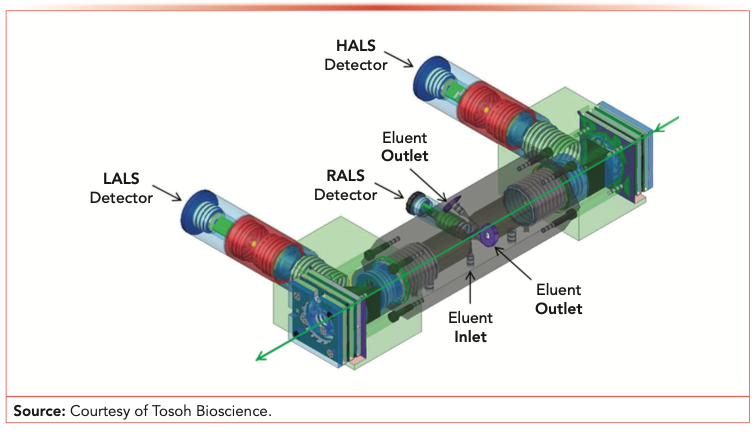
FIGURE 6: Schematic of the optical pathway of a highly sensitive SEC/multiangle instrument. The incident beam of a 505-nm laser diode passes through the center of the cell, allowing forward scattering to be measured at 10° (low-angle LS or LALS), back scattering at 170° (high-angle LS or HALS), as well as at 90° (right-angle LS or RALS). The low-wavelength light source, long optical pathway, and widely spaced supplementary scattering angles contribute to the high sensitivity of the detector.
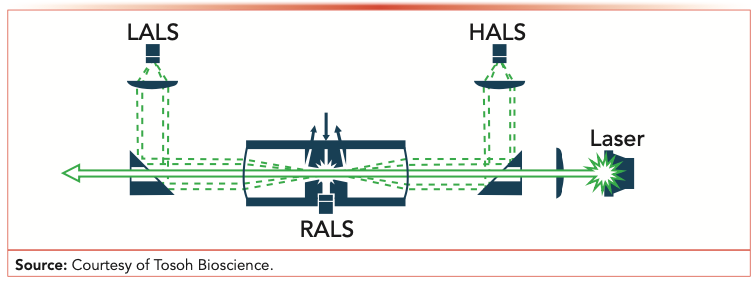
The high sensitivity and low baseline noise are demonstrated by the analysis of a mixture of styrene oligomers in tetrahydrofuran, ranging from dimer to nonamer. These data, given in Table I, show that the instrument is capable of measuring the molecular weight of styrene oligomers, as low as 260 g/mol for the dimer with an error of −2% when compared to the predicted value. Note that the same specific refractive index, 0.170 mL/g, was applied to all oligomers, which may have contributed to the progressively increasing error. The total mass of sample injected was only 0.43 mg of which approximately 30 μg was attributed to the dimer.
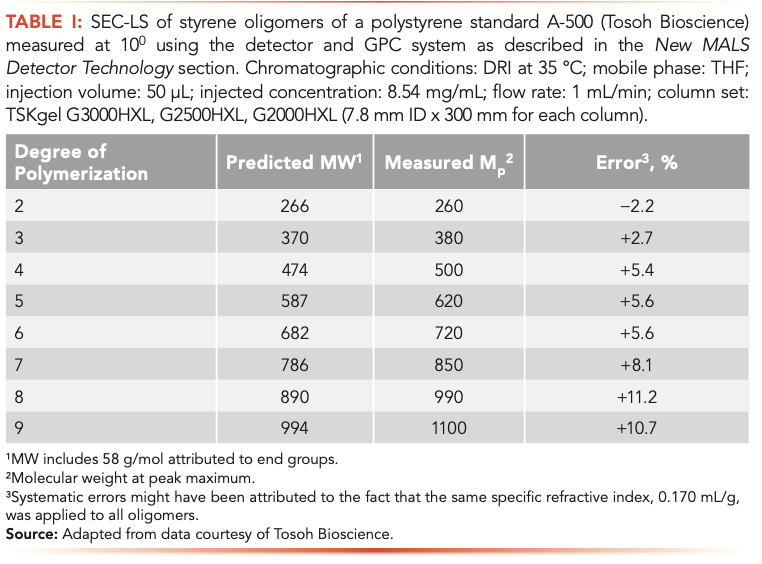
The LenS3 MALS instrument uses angular dissymmetry, rather than Zimm’s method, to calculate the radius of gyration. With this approach, the particle scattering function is represented as a ratio of scattering intensities,

in which I0° is the scattering intensity taken at 10°. Furthermore, an instrument normalization factor, Nθ, is employed that corrects for scattering volume, detector sensitivities, and distances from the scattering volume to the detector. Thus, for each elution volume increment, three particle scattering functions are generated:
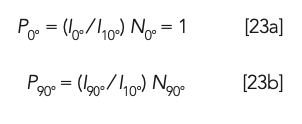

With this procedure, the particle scattering function (equation 9) can be expressed as:

By using an angular parameter,

equation 24 now becomes

which is referred to as the Guinier relationship (15). Since Pθ = Iθ ⁄I0° , equation 26a becomes

By plotting Iθ⁄I0° against μθ2 , the y-intercept is P0° = (I0° ⁄I10°)N0° = 1, and the initial slope (at the intercept) is –R2g/3.
An example of this angular dissymmetry approach is given in Figure 7, in which a broad polystyrene standard (NIST SRM 706a) was analyzed by the LenS3 MALS detector, courtesy of Tosoh Bioscience. Owing to a slight amount of curvature, a quadratic equation (Pθ = 1 – bμ2θ + cμ4θ) was used to fit the data, which gave Rg,z = 27 nm, in agreement with the literature value. Owing to the low noise level and high sensitivity of the instrument, only three angles are required for radius-of-gyration and molecular weight measurements.
FIGURE 7: Angular dissymmetry plot of a broad polystyrene standard (NIST SRM 706a) analyzed by SEC/light scattering using the detector and GPC system as described in the New MALS Detector Technology section. The particle scattering function, Pθ, measured at 10°, 90°, and 170° is plotted against the angular parameter, μθ2, where P0° = I10°Nθ, Iθ is the scattering intensity at angle θ, Nθ is a normalization factor, and μθ2 =(4π/λ)2sin2(θ⁄2). A quadratic equation was used to fit the data, in which Rg,z = 27 nm.
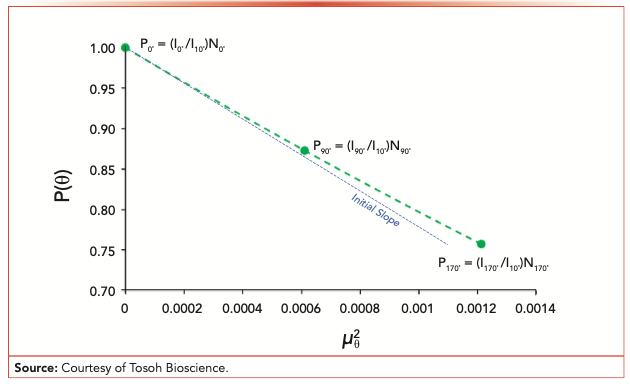
Table II shows preliminary molecular weight and radius-of-gyration data of a series of nearly monodisperse polystyrene standards, adapted from data supplied by Tosoh Bioscience. Radii of gyration were in agreement with literature data obtained from small-angle x-ray scattering, whose authors used similar lots of polystyrene standards dissolved in toluene (2). These initial results were well below the established limit of 10 nm. As previously noted, detection lim- its depend upon many factors that can contribute to the signal-to-noise ratio (S/N) of both the light scattering instrument and concentration detector, such as baseline noise and drift, column efficiency, injection amount, and specific refractive index of the sample.
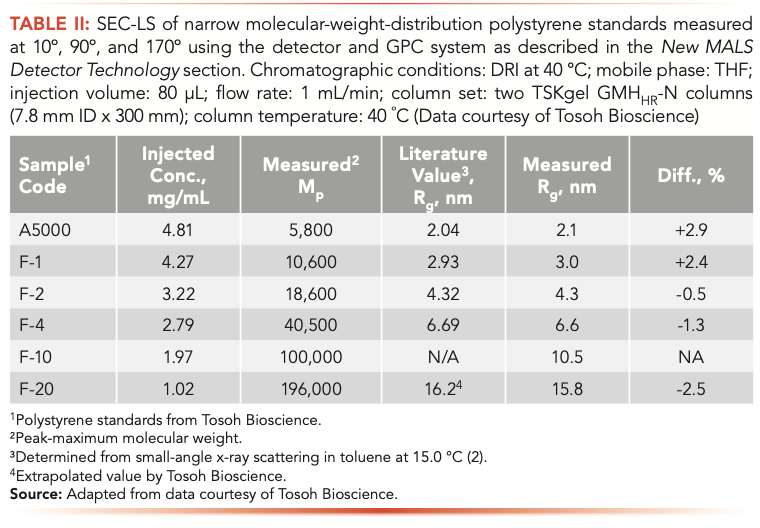
Conclusions
Light scattering is the ideal detector for SEC, because it provides molecular weight and radius-of-gyration distributions in addition to corresponding statistical averages without column calibration. With this detector, the only information that is required is the specific refractive index of the polymer and the refractive index of the mobile phase.
By using low injection concentrations, the Rayleigh equation is reduced from three (M, Rg, and A2) to two unknowns (M and Rg), greatly facilitating data analysis. Moreover, if low-angle measurements are used, molecular weight can be determined directly without resorting to graphical analysis, however, molecular size information is lost.
To increase the reliability of molecular weight and radius-of-gyration measurements, several instrument companies have opted to maximize the number of photodiodes that surround the flow cell; for example, Wyatt Technology, Malvern Panalytical, and Postnova Analytics have instruments of 18, 20, and 21 angles, respectively. Of late, Postnova Analytics and Tosoh Bioscience have instruments with green- rather than red-laser diodes, resulting in increased sensitivity. Furthermore, Tosoh Bioscience’s instrument consists of a newly designed flow cell and optical system that can mea- sure the radii of gyration as low as about 2 nm under ideal condition. With normal injection amounts, the radius-of-gyration limit is approximately 5 nm, and the molecular weight limit is below 500 g/mol for polystyrene.
For the reader’s benefit, a glossary of principal symbols and a summary of relevant equations and their significance are given, respectively, in Tables III and IV.
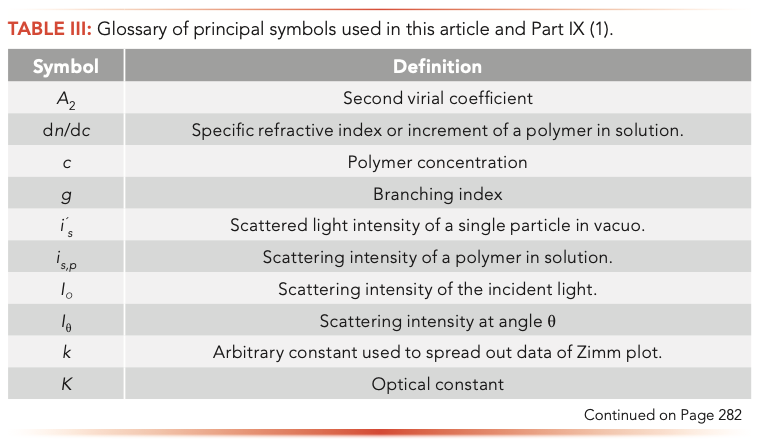
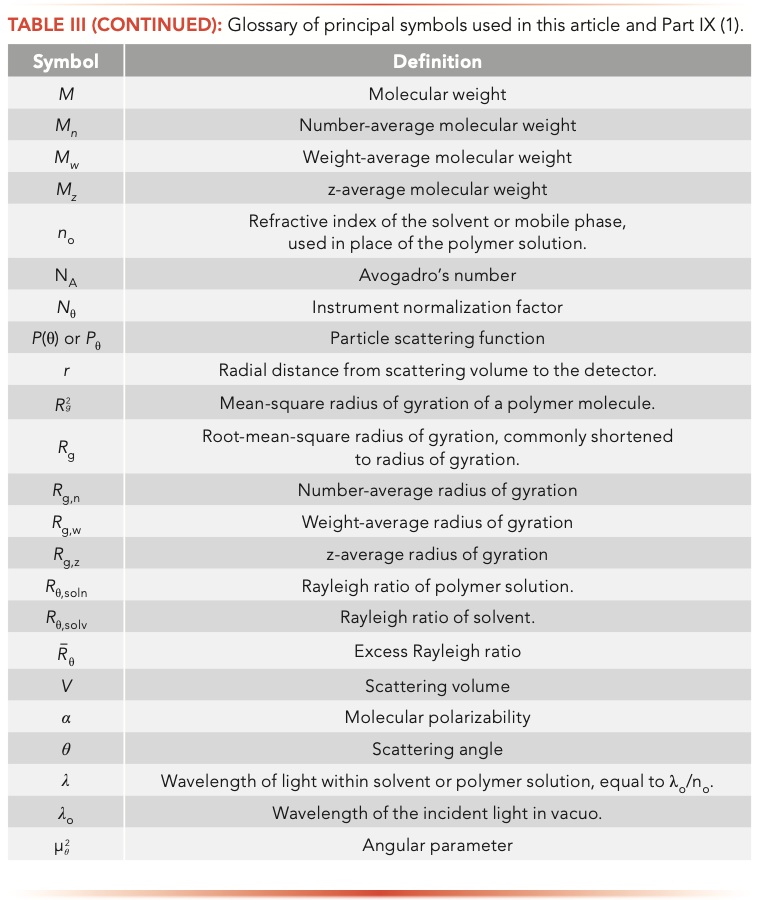
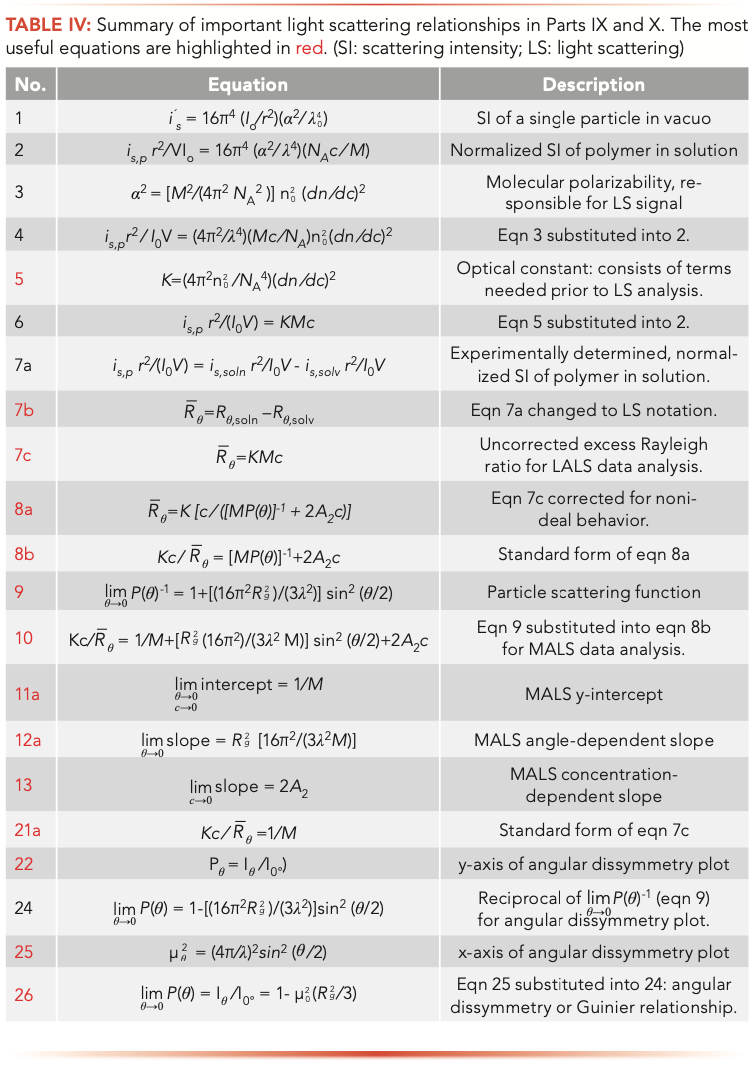
Parts XI and XII of "Chromatography Fundamentals" will be devoted to online dynamic light scattering and viscometric detectors, respectively.
Acknowledgments
The author gratefully acknowledges Cara Tomasek, David Gillespie, and Sébastien Rouzeau, all from Tosoh Bioscience, for their insightful discussions on light scattering and for providing figures and preliminary data on the LenS3 MALS instrument.
LenS is a registered trademark of Tosoh Bioscience LLC.
EcoSEC and TSKgel are registered trademarks of Tosoh Corporation.
References
(1) H.G. Barth, LCGC North Am. 38(10), 569–579 (2020).
(2) F. Abe, Y. Fumiaki, T. Yoshizaki, and H. Yamakawa, Macromolecules, 26(8), 1884–1890 (1994).
Howard G. Barth is with Analytical Chemistry Consultants, Ltd., in Wilmington, Delaware. Direct correspondence to: howardbarth@gmail.com.
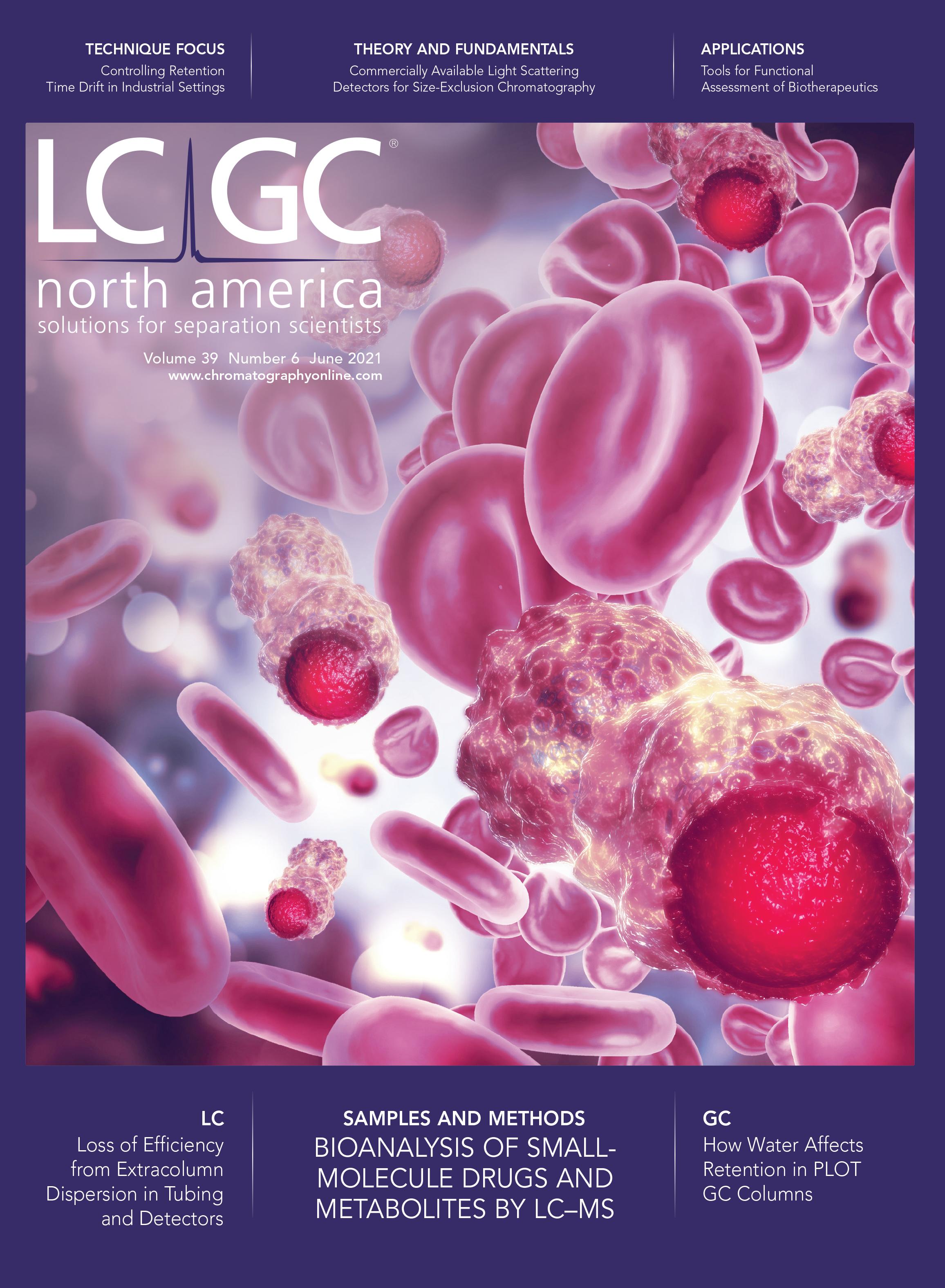
Characterizing Plant Polysaccharides Using Size-Exclusion Chromatography
April 4th 2025With green chemistry becoming more standardized, Leena Pitkänen of Aalto University analyzed how useful size-exclusion chromatography (SEC) and asymmetric flow field-flow fractionation (AF4) could be in characterizing plant polysaccharides.
Rethinking Chromatography Workflows with AI and Machine Learning
April 1st 2025Interest in applying artificial intelligence (AI) and machine learning (ML) to chromatography is greater than ever. In this article, we discuss data-related barriers to accomplishing this goal and how rethinking chromatography data systems can overcome them.
Influence of Concentration in Conventional GPC/SEC and Advanced Detection GPC/SEC
March 21st 2025Sample concentration is a parameter that can influence the quality of gel permeation chromatography/size-exclusion chromatography (GPC/SEC) separations and the obtained results. Understanding this influence can help to support the development of reliable GPC/SEC methods.







